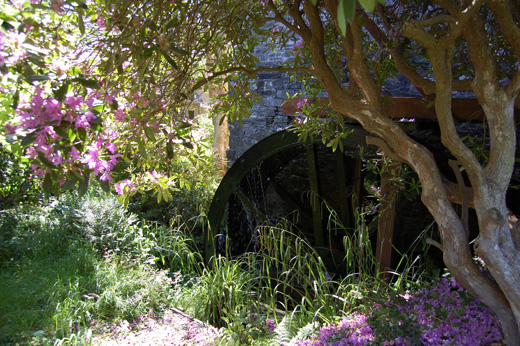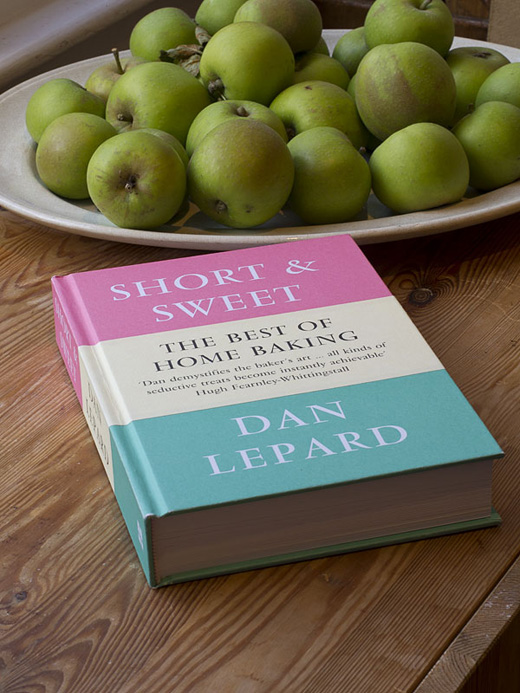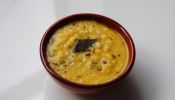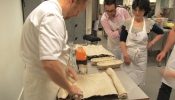Roland Feuillas runs courses on his ancient grains through his mill in Cucugnan, contact him, contact@farinesdemeule.com, 00 33 4 68 33 55 03 or via his website here. If passing that part of the world visit his bakery and taste the bread baked in his special wood-fire oven.
Words I associate with Roland are; passion, mission, generosity, kind, energy, leadership, entrepreneur, enthusiasm, devoted. By now if you’ve been keeping up with my week spent in the village of Cucugnan here, and reading all about my baking with Roland here, in his extraordinary wood fired oven here, you might have had some idea this was more than simply about baking some bread.
I wasn’t sure what to expect when I arrived but when I left I learnt something special. Yes, I learnt about particular stone grinding, special wood fired ovens and terroir. I was also introduced to Roland’s ancient grains, highlighting the contrast of just how far modern day wheat has been cross pollinated, not for the better of us or the planet according to Roland.

To Roland ancient grains and bread made from it is like a strongly held religious belief. It’s everything to him, within 24hrs in his company I was fully aware of this. Now, most of us have strong held beliefs, a passion for how something should be, but unlike most Roland has put his money where his mouth is, has transformed his life and lifestyle in order to do it; put his money into the fields.
I said on my last post how he calls himself a humble peasant baker and after spending last week with him I understood this to mean he wants to produce as simple as loaf as he can leaving his grains and his milling process to do the bragging. You won’t see here any time soon black squid ink rolls or miso loaves, oh no, that’s not what motivates Roland.
What has made him turn his back on a financially rewarding career in managing his own business in the computer industry and take up the role of farmer, miller and baker was twofold: the dire state of bread production in France and the belief if going back to planting crops as they were by our ancestors we will go a long way to restore some equilibrium to modern day wheat intolerances and health to the soil. A rather large task if you ask me. I would much rather be contemplating whether I should be using white or red miso in my designer loaf.

My feeling is that Roland thrives on serious challenges and he has certainly raised the bar high here. In a country which once could pride itself in a historic association with good bread but has now succumbed like here and other places to the modern practice of using F1 glutinous flour, high yielding, expedient wheat varieties, and the detrimental farming methods of it, Roland stands out as rare as his ancient grains.
Roland’s Ancient Wheat
The photos of wheat are Roland’s ancient grains growing in the fields he has bought near Cucugnan. To me, with unknowing eyes it appears no different to other fields of wheat, but then Roland pointed out if you notice the lack of uniformity in the heads of the wheat and in the height. On close inspection you’ll notice some heads have spikes growing out of them and some don’t, shorter, fatter, thinner or longer, there are 12 different varieties and he plants them all together.
The reason behind it is to follow the same logic as our ancestor farmers did, if one particular type of crop faces disease then the other varieties will survive. It also goes back to what we’ve been told regularly especially with our diets that variety is good, eating a bread made with different varieties Roland believes is also better for our health. Three of the varieties he grows are South West France Rouge de Bordeaux, Barbu du Rouissillon, Bladette de Puylaurens.
In some fields he grows ancient varieties of spelt, Poeme and Cosmos which he acquired from Belgium. Another common wheat variety he grows is Torka, which is suppose to be very good for pastries, containing high levels of lipids.
Growing the Ancient Grains
I had mentioned on my first post of Cucugnan how Roland selects a side of a nearby valley where the climate has an oceanic temperament more suitable for his wheat growing. He buys land that hasn’t had anything sprayed on, and one which is rich in its composition for growing crops.
He then plants the wheat without any fertilizers, this way Roland explains, the roots of the grasses are forced to go deeper and absorb more of the soils natural nutrients. As a result the roots of his wheat are 1 metre long, where’s in modern wheats they’re centimetres.
The yield for his crops is small, something like 1,000-2,000 kilos per hectare in comparison to modern yield of 8,000-12,000 kilos per hectare. The other disadvantage to Roland’s farming way is he only grows the wheat for one year in a three year period. The other two years it will be planted with ancient alfafa or maybe an ancient lentil variety. It’s important what you pick to plant when not growing wheat as it will have an effect on the quality of the wheat.
As you can see this method is not very attractive to modern farming, one year’s wheat growth out of three. Roland’s grains also take 9 months to grow, far longer than modern wheat varieties.
For Roland this was how it use to be done and there were good reasons behind it, to keep a balance of nutrients in the soil, not to rape it leaving it starving. He tells the story of how in many places when testing for the signs of good soil and looking for earthworms, none exist. To him growing his beloved ancient varieties goes hand in hand with the preservation of the earth it’s farmed on without question.
Wheat Intolerance
In the five years of owning Cucugnan’s Mill Roland has had feedback from some people unable to tolerate modern wheat who can enjoy his bread without consequences. This doesn’t surprise me, having a child with multiple food allergies since birth, and having milk intolerance that runs in my family as far back as my Great Gran down to me and my oldest daughter, I know how complicated and unknown this subject is by the medical profession. I can see how some people’s bodies who have come to reject today’s universal wheat varieties can accept a variety their body doesn’t recognise as toxin to react against. Same way why some can tolerate spelt but not modern common wheat.
Roland has recently collaborated with Fanny Leenhardt, who’s currently working at University College in Cork. Fanny’s phD was on “exploring the intrinsic nutritional qualities (mineral and micronutrients contents and bioavailability, digestive and metabolic impacts) of wheat and wheat based products using a multidisciplinary approach involving plant selection, agricultural strategies and transformation processes”. It will be interesting to see if in the future we will have more clear answers to the problem of wheat intolerances.
Milling the Grains
The other subject that illuminates Roland’s eyes is the milling. The stoneground milling is as intrinsic to the whole process for him as the growing of the wheat.
He has researched and sourced a particular type of granite. Now this is where my lack of French and Roland’s English was limited so I can’t tell you in detail what the process of the granite stones does, if you know better please feel free to chip in. As I understood it roughly, when the right two granite stones rub against one another they create some sort of static electricity and this causes a suction action to the outer layer of the wheat berries on grinding, removing it from the resulting flour.
This very simple mill you see here is a one-step mill, the stones on the right, the grain fed through the funnel at the top.
Into the granite stones the wheat berries go and crushed.
These stones grind about 70kg of flour an hour. The filter is made of silk.
The other of Roland’s mill is the more idyllic Cucugnan’s windmill visible from afar.
Green Flour
Roland uses fresh flour, also known as green flour. It’s important to him through the milling process the wheat germ stays in because it’s rich in nutrients but from my reading up on the milling process this also means it plays havoc with the shelf-life of the flour, it has to be used within weeks, about 8 weeks rather than months.
Do you remember seeing my post on Baking with Roland and how slack the dough was? Where I describe it as having “short” strands?
It appears the wheat germ (and bran which Roland tries to remove) ‘..interfere physically and chemically with the formation of continuous, strong gluten’ according to McGee. Yet with this disadvantage of both stone grinding and using fresh flour Roland does what some text books says you can’t…he produces light, well risen loaves.
Note on the Oven
I mentioned on my post of the wood fired oven how special the crust is but I should have also mentioned and I forgot how moist the crumb is. The reason I remembered this was because I baked a hybrid baguette yesterday and left it a bit too long and consequently it was a tad dry in the mouth. When something is on the dry side you feel it as it sucks the moisture in your mouth. Roland through the week kept saying “dry heat” and the differences in crumbs baked in different ovens. I got it, wood fired ovens not only produce an interesting delicious thin crisp crust, they also produce a moist crumb.
Roland advised me it’s importance when baking that the heat is not fierce from the bottom, a problem modern bread ovens have, his recommendation was to buy one you can control the temperature on the floor differently to the top heat. The heat should be hotter above the bread than under the bottom of it.
Just Don’t Ask for Baguettes!
By the way have you noticed how I spent a week in France with a baker and not mention the B. word? Word of advice, if you pay a visit to Roland’s idyllic mill and cosy bakery, and I very much hope you do, don’t ask for them. He hates doing them. But if on the off chance he happens to make some to sell say you want them for sandwiches, he’s ok with that. They’re too much faffing around with for his idea of the perfect loaf.
Roland has faced adversity getting this far. Not everyone has understood his yearning to change his livelihood and as some viewed it, become a mere baker. He also had problems with his first venture 7 years ago when he bought a bakery. He encountered entrenched traditional French bakers and their ways, unwilling to accept change. After a year of struggling with it, Roland saw no other way of going forwards than selling the bakery and buying the mill in Cucugnan where he could establish his dream of field to table.
Roland has a big charismatic personality with abundant energy, he feels a deep sense of wanting to show an alternative way to today’s wheat production, an ancient way. It isn’t a glamours job really, he could have chosen a different life for himself, an easier more relaxing one but I’ve told you already, it’s his religion, there is no other life.












































{ 17 comments… read them below or add one }
amazing. Thank you for linking me with another humble peasant baker. I too build wood fired ovens and bake honest bread. In sussex
i will be visiting cucugnac as soon as possible
honey in the hearth
hi Michael – nice to know you! Do pay a visit to Cucugnan it’s scenery alone is worth a visit, but I’m certain you’ll love seeing Roland’s oven.
xx carla
Milling flour is a fabulous adventure! We have a small refurbished mill near my hometown ( http://moulinsemblanet.ch/moulin.html ) but underused… shame.
Interesting… the word B.
It is a shame Gregoire, I see there’s an oven too, this is that oven I saw in the video you had where the village baked together isn’t it? I wonder if in your hometown green flour is traditional?
I love B. because I love crust so much, the perfect ratio for me! One day I’ll have to taste yours!
Great article Azelia, I am going to repost on my forum. Thanks!
Yes share out the wonderful work of Roland Teresa!
Beautiful!
I am jealous of your experience but we also met another baker in Aquitaine, French Basque Country (Matthieu Mendizabal) who shared with us his project to make bread. He showed the mill (Astraie, isn´t it?) to us and talked to us about the initiative of recovering old varieties of wheat by taking care of the soil.
I have enjoyed very much reading your post.
Greetings from Spain
hi Teba – how wonderful to have met someone like Matthieu. I know Roland went to another part of France this week to meet an old miller/baker doing his own thing. So there are a few of them around, wish they were more well known, they are the ones who should be “celebrity” bakers!
hi azelia,
what does Roland grow for the years he doesnt grow wheat, and how does he get his flour then? I really wish i could taste this bread for myself. It is the very antithesis of mass-produced. it’s really something to have in your hands a loaf of bread that you see from seed to loaf. Out of curiosity, how much does he sell a loaf for?
W
hi W – did you miss where I said ancient lentils or ancient alfafa? The idea is he has different fields he rotates. I’ll have to ask him how much now, I forgot, it’s sold per kilo. I’ll email him tomorrow.
The idea is he has different fields he rotates. I’ll have to ask him how much now, I forgot, it’s sold per kilo. I’ll email him tomorrow.
oops must have missed that. Just curious abt the price, don’t bother too much, thanks!
Hi Azelia,
Fascinating to see your photos and read about your week with Roland. Thank you.
A note on shelf life for freshly stoneground wholemeal …the Traditional Cornmillers Guild recommend six months as a best before date, assuming the flour is stored in a cool,dry place. I’ve baked with flour we’ve kept for 9 and 12 months after milling as a test and it’s been fine. Having said that there is something special in the flavour of newly milled flour and in practice we like to mill to order as much as we can. Then, of course you get to the question of ageing flour to improve the performance of the gluten. So many threads to weigh up and consider!! A.
hi Anne – that’s interesting about the fresh flour, does your flour also contain the germ? Or is the germ automatically processed into stoneground flour whether you want it or not?
Yes ageing is something I’ve read about and the performance of gluten but after watching Roland dealing with what you and I might consider fairly weaken gluten and produce lovely risen light crumb I’m now more convinced than ever the obsession with gluten in bread flour by bakers is because they haven’t learnt how to use the right formula to deal with flour that’s different.
Your job is difficult because you’re selling flour to bakers & bakeries who I suspect fall into the typical spectrum of gluten obsessed. As I’ve said on twitter you’re on my list to try and experiment with, looking forward to it.
Hi Azelia,
Yes, the germ is automatically in all stoneground flour. Even a sieved white stoneground will have the germ in, so a creamy colour, great taste and better nutritional value than white from a modern roller mill.
I’m sure you’re right about the gluten obsession. We mill a locally grown wheat (wet, West Wales would not be considered ideal wheat growing country) which is technically very soft, but treated properly produces delicious loaves. This is what Mick Hartley does with it.. http://thepartisanbaker.com/2011/08/31/felin-ganol-wholemeal-2/ We’re fortunate to be milling for Rick Coldman (Mair’s Bakehouse) who is passionate about baking, lower gluten flours and his beloved Alan Scott oven, and he spurs us on to experiment all the time, so it’s still more fun than work!
Thanks for the info on the germ Anne. I am most intrigued by your local grown wheat, will be putting an order soon to try it.
Hi Azelia,
Just to agree with Anne and Roland on subject of fresh or “green” flour. You can read that white (roller milled) flour should be aged for up to 3 and half months before use as it gets whiter and gluten stronger, at the same time you will read wholemeal flour should be used within 3 weeks as the oils from the germ in it go rancid. If as Anne writes you are using stone ground white flour you then have a dilemma – it will still inevitably contain some germ (and oils) as the whole grain is milled together and only afterwards sieved – as opposed to roller milling where to make wholemeal the different “streams” taken off different layers and parts of the grain in the milling must be added back together. At Brockwell Bake we use our own “green” totally fresh flour to bake with but as an experiment have saved some for several months and can’t say I notice appreciable difference in colour or baking qualities so going to stick to fresh.There does seem to be a consensus that fresh is more nutritional and personally I think more flavoursome. Of course most big millers would like to put as long a shelf life on their product as possible.
I believe French flour is typically aged – I am told if things go wrong French bakers will blame the miller for not having “bien planche” the flour. Interestingly the Dutch miller and millstone builder Hans Titulaer http://www.molenstenen.nl/?lang=en whose mill is near border with Germany told me that Germans have always preferred flour as fresh as possible, Dutch used to prefer aged but now prefer fresh.